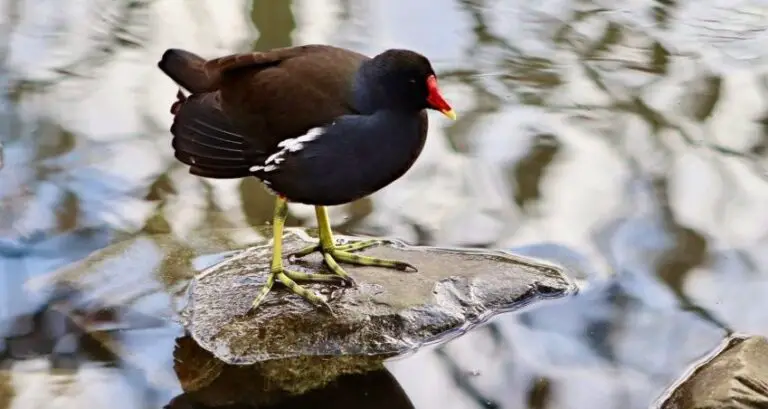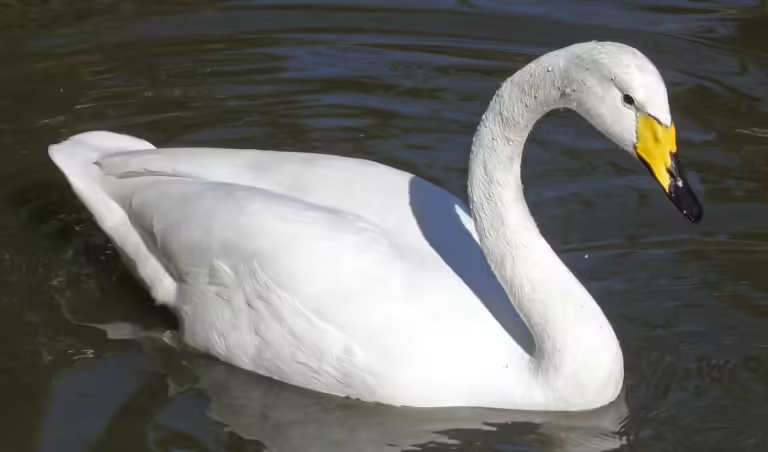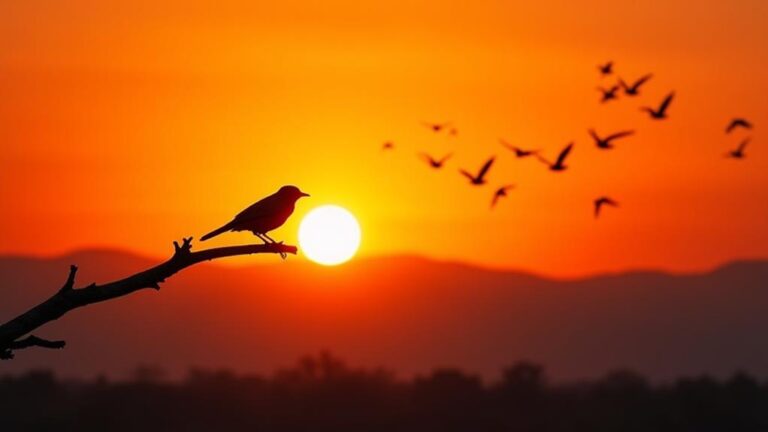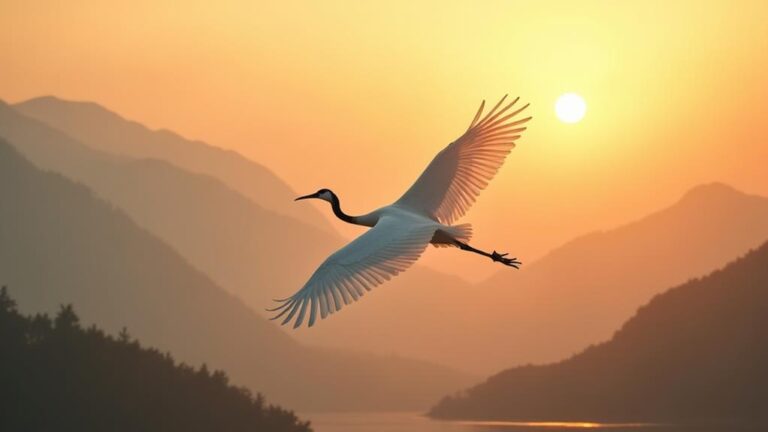You might be surprised to learn that over 120 million ducks, geese, and swans inhabit our planet, with each species boasting unique characteristics that set them apart. While they may seem similar at first glance, these waterfowl have evolved distinct traits to thrive in their environments. From beak shape and size adaptations to feather color and pattern variations, each species has developed specialized features to survive and flourish. But what exactly are these differences, and how do they impact their daily lives? As you explore (Ducks Vs Geese Vs Swans) these fascinating birds, you’ll discover the intriguing ways they’ve adapted to their worlds.
Key Takeaways
- Beak shape and size adaptations in ducks, geese, and swans determine their feeding habits and food sources.
- Feather color and pattern variations among the three species are influenced by molting patterns and camouflage needs.
- Habitat and migration patterns differ, with ducks thriving in freshwater habitats, geese preferring grasslands, and swans requiring larger spaces.
- Body size and posture variations, including neck and leg lengths, are adapted to their specific habitats and lifestyles.
- Behavioral quirks and noises, such as honking, quacking, and hissing, serve distinct communication purposes for each species.
Beak Shape and Size Matter
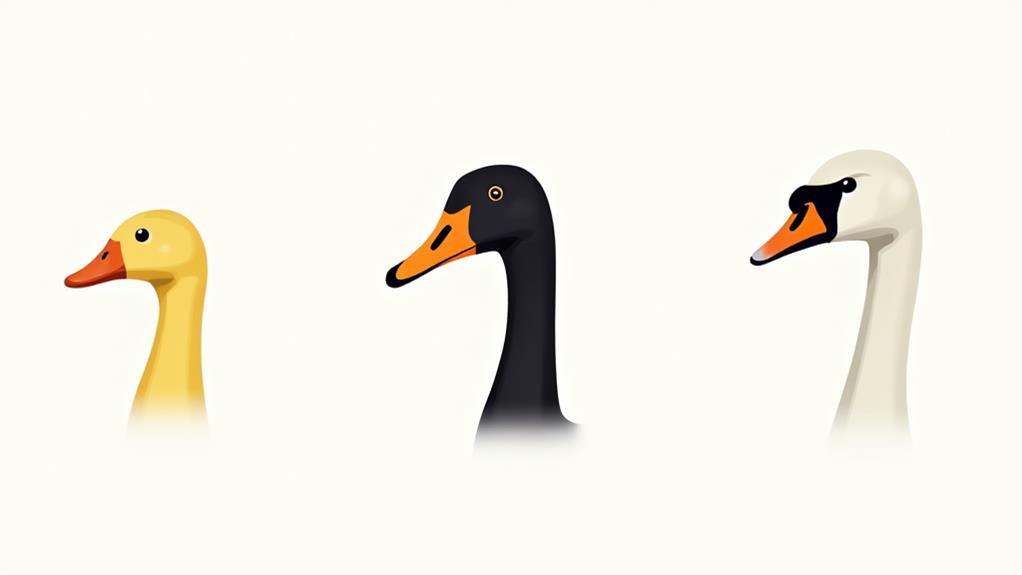
Three distinct beak shapes and sizes characterize ducks, geese, and swans, each adapted to their unique feeding habits and environments.
You’ll notice that ducks have a broad, flat beak, ideal for filtering small plants and invertebrates from mud and water. Geese, on the other hand, have a longer, more pointed beak, perfect for grasping and tearing at grasses and aquatic plants. Swans boast a long, slender beak with a soft, sensitive tip, allowing them to forage for soft vegetation and aquatic delicacies.
Beak strength tests have shown that these adaptations aren’t just superficial.
The beak tip shape and size directly correlate with the forces required to gather and process food. For instance, ducks require less force to filter small particles, while geese need more strength to tear at tough plant material. Swans, with their sensitive beak tips, can detect and grasp delicate food items with ease.
Feather Color and Pattern Differences
One of the most striking visual differences among ducks, geese, and swans lies in their feather color and pattern variations.
You’ll notice that ducks typically display a wide range of colors, from muted browns and grays to vibrant blues and greens. Their feathers often exhibit intricate patterns, such as stripes, spots, or patches, which can be influenced by their molting patterns.
Geese, on the other hand, tend to have more subdued coloration, often featuring shades of white, gray, and brown. Their feathers may display a subtle sheen, but lack the iridescence found in some duck species.
Swans, with their majestic appearance, boast a primarily white plumage, although some species may exhibit a yellow and black coloration on their heads and necks. Their feathers are often longer and more luxurious than those of ducks and geese, giving them a regal appearance.
Habitat and Migration Patterns
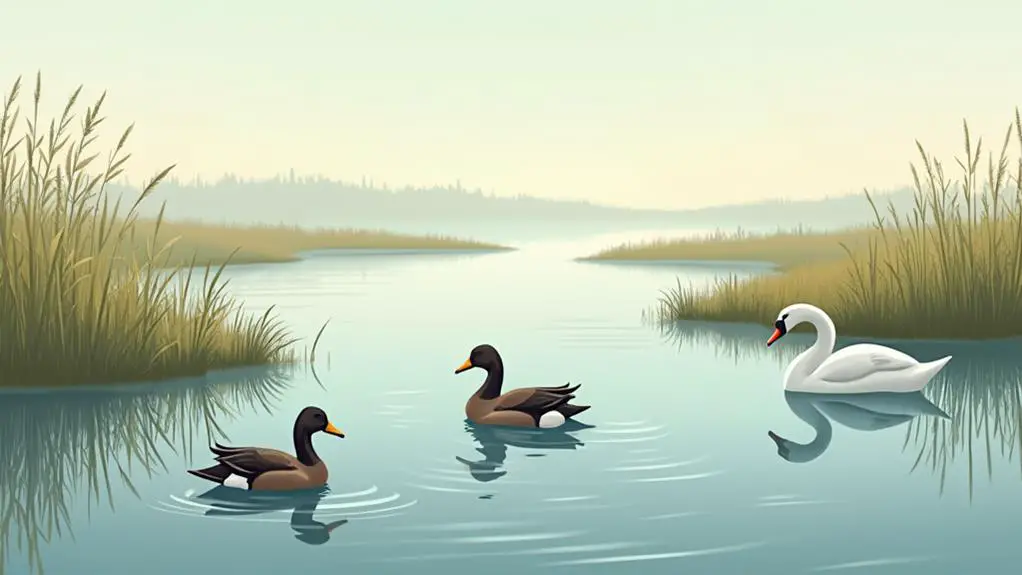
Wetlands, marshes, and ponds serve as the ideal habitats for ducks, geese, and swans, but each species has its unique preferences.
You’ll find ducks thriving in freshwater habitats, including wetland dwellings, rivers, and lakes. They’re adapted to aquatic environments, with some species even inhabiting coastal areas and estuaries.
Geese, on the other hand, prefer grasslands, fields, and parks, often venturing into wetlands during migration.
Swans, being large and majestic, require more space and typically inhabit larger freshwater habitats like lakes, rivers, and coastal areas. They’re also known to occupy wetlands, but tend to avoid densely vegetated areas.
When it comes to migration patterns, ducks are partial migrants, with some species making short-distance movements while others remain resident. Geese are well-known migrants, traveling in large flocks between breeding and wintering grounds.
Swans, too, migrate, but their patterns are more complex, with some species making short-distance movements while others travel thousands of miles. Understanding these habitat and migration patterns can help you identify the species you’re observing.
Body Size and Posture Variations
Most ducks, geese, and swans exhibit distinct body size and posture variations that can aid in identification.
As you observe these waterfowl, notice how their body size and posture differ. Ducks, for instance, are generally smaller, with a more compact body and shorter legs.
Geese, on the other hand, are larger and have longer necks, which allow for greater neck flexibility. This flexibility enables geese to forage for food in deeper waters.
Swans, the largest of the three, have an elongated neck and legs, giving them a more majestic appearance.
When examining leg structure, you’ll find that ducks have shorter, stouter legs, while geese and swans have longer, more slender legs.
These variations in leg structure are adapted to their specific habitats and lifestyles. For example, ducks’ shorter legs are better suited for walking in dense vegetation, whereas geese and swans’ longer legs are more efficient for wading in open waters.
Behavioral Quirks and Noises
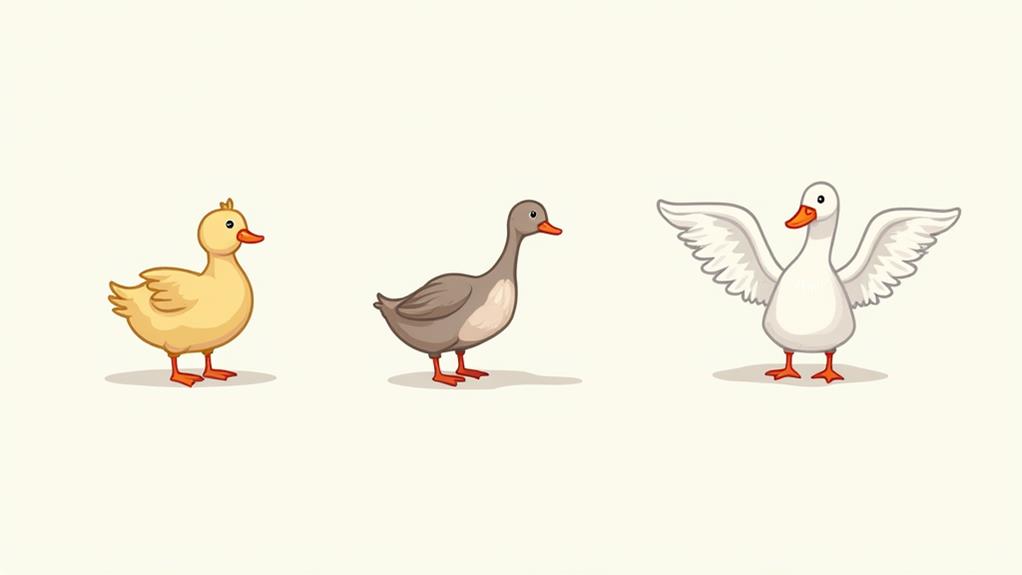
Get up close and personal with ducks, geese, and swans, and you’ll discover a range of behavioral quirks and noises that set them apart.
One of the most distinctive traits is their vocalizations. Geese, in particular, are known for their loud, aggressive honking, which can be a warning call to alert others of potential threats.
In contrast, ducks tend to quack softly, often to communicate with their young or mates. Swans, on the other hand, produce a variety of hisses, grunts, and whistles to convey aggression, courtship, or alarm.
When it comes to social behavior, these birds exhibit unique characteristics as well.
Geese are renowned for their strong social bonds, often forming long-term monogamous relationships. They also engage in social flocking, where large groups congregate to forage, roost, and migrate together.
Ducks, although social, tend to form looser associations, often gathering in small groups for feeding or breeding purposes.
Swans, while also social, are generally more solitary, only coming together during breeding season or to protect their young.
These behavioral quirks and noises are essential to understanding the intricacies of each species‘ behavior and ecology.
FAQs: Ducks Vs Geese Vs Swans
Can Ducks, Geese, and Swans Coexist Peacefully in the Same Environment?
You’ll find that ducks, geese, and swans can coexist peacefully in the same environment, but it’s crucial to understand flock dynamics and habitat sharing, as these factors significantly impact their ability to harmoniously cohabitate.
Do These Birds Have Any Natural Predators in the Wild?
You’d think these birds have it easy, but surprisingly, they have many natural predators in the wild! You’ll find them employing predator avoidance strategies, like habitat segregation, to stay safe from foxes, coyotes, and owls that lurk in their surroundings.
Can They Be Domesticated and Kept as Pets?
You can domesticate these birds, but it requires careful consideration of their breeding habits and commitment to regular feather maintenance; however, with proper care, they can thrive as pets, providing unique companionship and fascinating behavior to observe.
How Long Do Ducks, Geese, and Swans Typically Live?
You’ll find that ducks, geese, and swans’ lifespans vary, influenced by factors like migratory patterns and habitat preferences. On average, ducks live 2-5 years, geese 10-20 years, and swans 20-30 years in the wild, with domesticated individuals often living longer.
Are They Monogamous or Do They Mate With Multiple Partners?
You might assume that waterfowl are promiscuous, but surprisingly, many species form long-term monogamous relationships. In fact, ducks, geese, and swans are known for their strong pair bonding, with some species exhibiting faithful mating habits that last for many breeding seasons.
Conclusion
As you wade through the wonderful world of waterfowl, you’ve witnessed the distinctive differences between ducks, geese, and swans. From beak shape to behavioral quirks, each species flaunts its unique features. Feather patterns flutter, habitat habits hover, and body sizes bulk up, broadcasting their individuality. Now, you’re well-versed in the five fabulous facets that firmly fix these feathered friends in their separate spheres.





